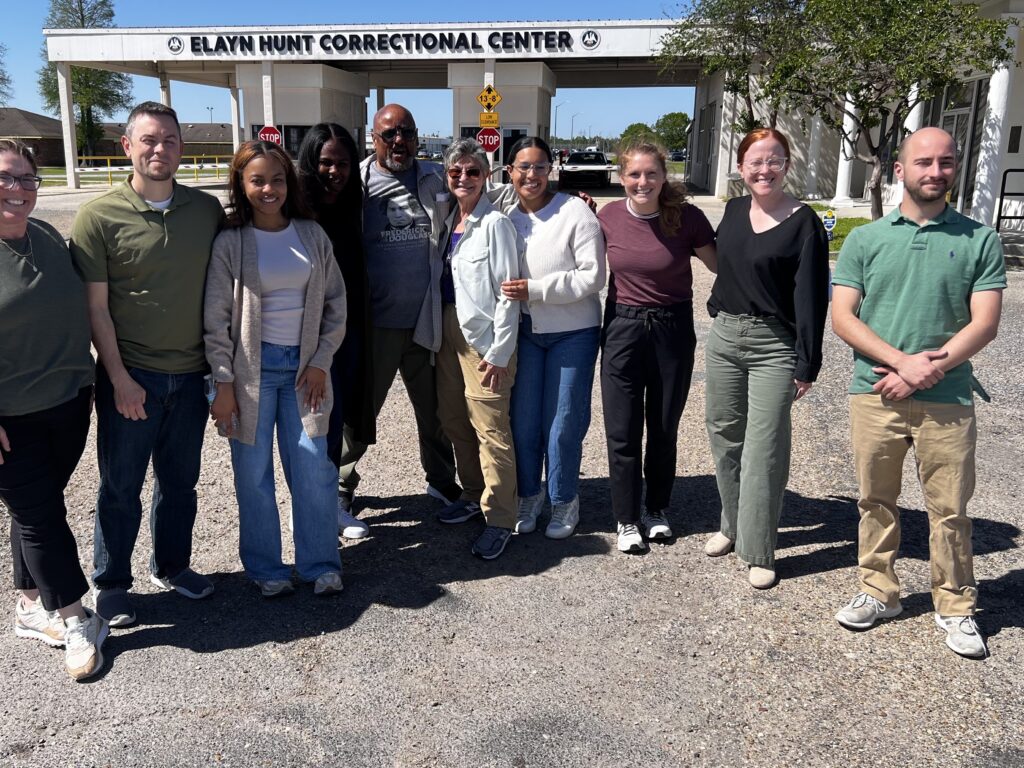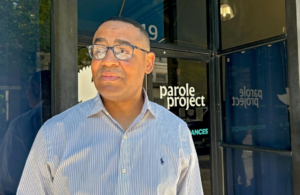By April Myers, Louisiana Parole Project Communications Manager
On a beautiful Friday in April, with a gentle breeze that made the lush green leaves on the Bur Oaks sway, I left my home to drive 39 minutes to enter a men’s prison in St. Gabriel, Louisiana. Three hours later, I left a different person.
Along with nine other volunteers, three men and seven women, we participated in the Frederick Douglass Project for Justice. Launched in 2020, the nonprofit’s mission is to “facilitate structured meetings and respectful conversations between members of free society and incarcerated people to learn from each other and form a human connection.”
Georgetown University professor Marc Howard started the nonprofit after visiting his childhood friend in prison who had been wrongfully convicted of a double murder. That spurred his passion for prison reform and eventually to create the Frederick Douglass Project. I became aware of it through Louisiana Parole Project a Baton Rouge nonprofit with which I recently accepted a full-time position. Parole Project helps formerly incarcerated people rebuild their lives after release.
The week before the visit, I scoured the Frederick Douglass Project’s website. I read and reread all of the emails from Matt Pineda, Community Engagement Manager at Parole Project, who coordinates the Frederick Douglass Project volunteers.
The rules were clear. The visit is three hours long. You tour the prison as a group and then meet with incarcerated people to talk and connect. You can only bring in one key (for your automobile) and your ID. The dress code was strict: “no camouflage, white or gray T-shirts or sweatshirts, no light blue polo style or light blue chambray shirts, no tights, shorts, leggings, spandex, open-toed shoes or transparent clothing items. No torn or ripped jeans or pants will be admitted. A collared shirt and slacks or khakis are fine.”
The morning of the visit, I looked in my closet and all I saw were white, gray and denim button-down shirts. I spent an embarrassing amount of time trying to figure out what to wear. I texted Matt about earrings and necklaces.
Are they OK? I asked.
He quickly responded. Yes.
I kept the necklace but decided the earrings were too much. I was nervous. I didn’t know what I would say or how I would act or if I would ask too many questions or not enough. I didn’t know if it would be hot or scary or depressing.
My limited experience with prisons came mainly from TV and movies and my dad’s random nuggets of wisdom. He spent 20 years working for the Federal Bureau of Prisons (FBOP) in upstate New York.
His repeated advice:
“Don’t get in the system.”
“Prison is punishment. Not for punishment.”
“Not everyone in prison deserves to be there.”

Elayn Hunt Correctional Center (EHCC) is an 1,800-bed men’s multi-security level prison. Louisiana has the highest incarceration rate in the United States, with 1,067 people incarcerated per 100,000, according to the Prison Policy Initiative. Hunt is one of nine state prisons across the state.
It’s named after Elayn Hunt, the first woman to head corrections in the state and the second in the country. An advocate for criminal justice reform in Louisiana, her reputation not only earned Hunt the name of the prison, but a wall of photos and stories dedicated to her in the lobby of the visitor center.
The visitor center was the first stop after we made it through the gates on a prison transport van. When the van stopped, one of the volunteers, an LSU Law student, tried to open the door from the inside. One of her friends joked with her that of course they didn’t open from the inside as the correctional officer opened the door from the outside to let us all out. I leaned over and whispered to her, “I would’ve done the same thing as you.” She smiled and said, “Right?”
As we walked inside there were two sets of white gates ahead of us. They reminded me of the butterfly exhibit at the now shuttered Insectarium in New Orleans where visitors had to wait for the first door to close before opening the second door so the butterflies wouldn’t escape. The visiting room was to the right of the gates, and it was filled with custom jewelry, leather purses, wreathes and engraved wooden signs, including one that read, “Alexa do the dishes.” Each product included a small piece of paper with the price and the name and ID number of the incarcerated person who created the product. There were rocking chairs, metal planters in the shape of pigs, and benches with the New Orleans Saints logo on the side.
“We got a lot of gifted guys here,” said Paul Murray, Senior Chaplin at EHCC, who along with Program Manager Charis Ward led us on our tour.
We formed a line at the check-in booth and after signing in, a correctional officer checked our IDs and scanned us with a hand-held wand.
We’re all quiet, curious and reverent, not quite sure what to expect. When we finished with the security check, we walked outside to a covered walkway anchored by two chain link fences and topped by razor wire. There are two sets of spraypainted yellow lines on the walkway, a reminder to stay to the right when walking.
I noticed the incarcerated men were all dressed differently, in white pants, blue jeans, shorts, and some wore T-shirts and blue chambray shirts. I saw two men wearing gray sweatshirts with black letters down the side that spelled out “Inmate,” but I was surprised that they looked like men dressed like they would outside prison. Prisoners on TV are depicted in orange jumpsuits or sometimes the black and white striped jumpsuits. I felt dumb thinking that everyone would be dressed the same here, but a correctional officer reminded me that we were in the medium security part of the prison and not the maximum. I wonder if those men were dressed differently.
We stay in our group but chat amongst ourselves respectfully nodding our heads in greeting and occasionally saying hi to anyone who looks interested in talking. Some men are holding books, others are headed to the chow hall. It’s not scary. I didn’t feel unsafe. I felt like I was at a very secure summer camp for men.
A man rode by on a golf car, his nametag said, “Coach of Recreation Department.”
“What is he the coach of?” I asked Matt.
“They’re all sorts of sports and clubs that these guys can be part of,” he replied.
Our first stop on the tour is at the Young Adult Program. It is a cellblock that reminds me of the sun that my daughter used to draw when she was younger. The round ball in the middle is the security center and each ray is a tier. There are four tiers in the Young Adult dorm which houses men ages 18 to 25. I count 13 twin-size beds on each side of the tier, for a total of 26 per section. At the end of each bed is a black chest, similar to the one my daughter packed for camp and each man also has a black locker to the side of his bed. There are two flat screen TVs at the front of the tier. There’s a whiteboard with motivational quotes on the wall next to the TVs. A camera is propped up in the corner and large fans drown out the voices of our guides. The black bars are propped open, and I wonder if they close at night and what that noise sounds like.
“You can take advantage of all of the educational services here for free,” said Charis Ward. “Once they are released, they have to pay for them out there. So it makes sense to take advantage of what’s being offered.”
You have to apply to get into the program and you have to maintain a strict schedule and good behavior to stay in it. Those who are accepted into the Young Adult Program go to class and each have a job on their tiers. Their crimes carry a sentence of two to three years, I hear Ward say. Most don’t have a high school diploma.
“I’m 24 years old,” said a man named Cam, wearing a yellow T-shirt that says “Young Adult Program” on the front right pocket. “What I didn’t have was guidance, a mentor. I have that in here. I’m a reflection of them. They are a reflection of me.”
A lot of men have gathered around us as we stand awkwardly in a circle in what kind of feels like their bedroom/living room. I feel a little bit intrusive being in their space, but no one seems to mind, they are just interested in us being here.
I lean over to one of the correctional officers and asked her if they were given a heads up that we were coming.
“Of course,” she said.
“Is it usually this clean?”
“Yes. These guys take really good care of their area.”
“She said they are only here for a few years. Do you have any idea of what their crimes are,” I ask.
“No,” she said. “I make it a habit to not ask about their crimes. It could make me biased.”
We walked back outside, under the overhang and razor wire and I was so glad to be outside in the fresh air. I wondered what it’s like to be locked up for 23 hours per day.
That’s what life is like for some on the maximum side, Matt said, a stark contrast to what we had seen so far.
Our next stop was the “Vets dorm,” a Veterans Mentorship Program. It’s identical to the Young Adult Program tier but instead of the tiers labeled “A,” “B,” “C” and “D,” they are assigned a “Alpha,” “Beta,” “Charlie” and “Delta.” There’s a sign that reads “Veterans lives matter.”
John Thomas, an incarcerated man who is a coordinator for the Vets program was dressed in a baseball cap, blue jeans and a long-sleeve, dark-gray waffle-knit shirt. He talked to us about structure and discipline, how everyone has a cleaning task, and why the tiers are like squads and families, similar to the military.
He shared a snapshot of his story and ties his trauma to his criminality.
“Trauma is the cause of it,” he said. “Once you deal with trauma, you see that recidivism rates are down, write ups are down.” He said when he was younger, he was a violent kid who viewed the world from a negative perspective which led him to crime. He didn’t share what his crime was and we didn’t ask. One of the pillars of the Frederick Douglass Project is allowing people to have their dignity without being invasive.
“I just had this tint on my glasses that got darker and darker, and I was hurting,” he said. “And it led me to use drugs and alcohol which led me down a dark path.”
We left the Vets dorm and backtracked past the Young Adult tier to the chapel. On the walk over, I chatted with another volunteer, an older woman named Mary who retired from the IT Department at LSU and said she feels like this was her second calling to justice work.
The chapel looks like any other church I’ve been in but there’s a large circle of chairs and 10 incarcerated men greeted us, dressed in varying shades of grays, whites and blues. We all shook hands, introduced ourselves, talked about where we were from and what makes us feel the most vulnerable and from there separated into small groups of big talk.
Our group consisted of three volunteers – me, Mary and a man wearing a Frederick Douglass T-shirt who regularly volunteers in prison ministry. Two incarcerated men rounded out our circle of chairs – Troy who had been in prison for almost 32 years and Frederick, who had been incarcerated since 2010. We all shook hands.
Frederick wore white jeans, a gray polo shirt with yellow embroidering that read EHCC Peer Minister and Troy wore jeans with a gray T-shirt with Ashland University across the front–in purple letters. They were both soft-spoken with soulful eyes, deep with remorse and hope and a deep peace that can only stem from deep faith. They talked openly about their resolved spirituality, surrendering to God’s plan, accountability for their actions, and God’s grace. They are both mentors to younger incarcerated men, leaders in the prison and chapel, and when they spoke, they were intentional and deliberate.
They were also really good listeners.
They said they meet with Frederick Douglass Project volunteers once per month, so they are used to this kind of deep talk. We all pull out our list of prompts that Matt handed us, a guide for small group discussion, with questions like “How do you cope when things get hard?” and “What is the one thing you would like to change about yourself today, and why?” but we all decided to go off script and talk. We talked about a punitive prison system, the cost of incarcerating people long-term, restorative justice, reconciliation and accountability. They shared a little bit about their crimes, both convicted of murder.
“I graduated from Southern University, and I had two supportive parents,” Frederick said. “I made one bad decision. One awful decision. And that decision erased thousands of good decisions.”
“I understand that I have to pay a penalty to society, but there are a lot of people here who have been here a long time and are ready to go home and not be a threat to anyone else,” Troy said. “And if you’re paying more to keep a person incarcerated than you are a school teacher, I have a problem with that.”
Time flew as we talked. And just as quickly as we began, our time was up. I felt like I had learned a lot about a complex system and barely touched the surface. I could have talked to Frederick and Troy for hours. I wanted to spend more time with Mary. I felt a connection with this entire group.
We stood up and put our chairs back and embraced, before heading back to the big circle to share our experiences with the rest of the larger group.
Matt read the reflections, “One thing I have in common with someone I met today….”
“We all have similar hearts,” said a volunteer named Trevor.
“My mind was changed about…”
An LSU law student shared that she always thought she wanted to be a prosecutor but after her visit today, she’s not so sure.
“One thing I learned today…”
Mary said: “I have gratitude. I am grateful for our experience today. I have sadness for the people who are here and sadness for those who have apathy and revenge in their hearts but joy and hope for the love we all shared today. I’m grateful.”
An incarcerated man with glasses said, “There are good guys in prison, and I want you all to go out there and share that. There are a lot of people here who need to go home.”
As we wrapped up our time together, I still had so many questions, and I felt like my brain was packed with so many questions and so few answers. I was still so unsure about incarceration and the system, knowing that people need to be held accountable for their crimes, but for how long? And at what cost?
But as Matt asked the last question of the day, I knew that I could answer this one with one simple word.
“How many people can say I went to prison today and it was not what I expected?”
I raised my hand.
“Me.”
If you would like to visit a prison through the Frederick Douglass Project for Justice, click here or email Matthew Pineda, Community Engagement Manager at Parole Project.




